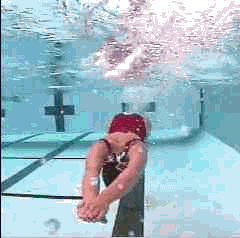

Fools Treasure Hunt
Underwater kicking, steering and surfacing
The start does not end at the water entry.
There are three distinct phases of the start:
1) The Launch - starting block technique, positioning, thrust and
trajectory
2) The Dive - entering the water, changing direction, and the Magic Surge
3) The Breakout - transitioning from the Magic Surge to surfacing to full
stroke
The previous eight Stages that have brought you here comprise the first Phase, or first one-third of the start. Stage 9 is a summary of the next two Phases
The momentum created by the start must be maintained for as long as possible and that is covered in the next phase (the dive into the water). Then we will cover surfacing and the breakout. (These last two sections of the three phases are covered in more detail at our Advanced Clinics.)
Streamline
The arms should reach out in front, making the body as long as possible. The back should be arched to steer the body back up to the surface. Point your toes on entry and glide only long enough to take full advantage of the dive momentum.

Generally the swimmer attempts to minimize frontal resistance by placing their arms together in front of their body while also maintaining as little motion as possible in the upper body.
The swimmer during the start part of swimming should not use his arms for propulsion as, too much resistance is created and reduces the gliding speed, unlike the stroke part of swimming.
The underwater velocity at this point is as much as or even more than 4 meters per second. The secret now is to maintain this velocity for as long as possible. The deeper you go the quicker you will slow down. This is why we call this position "Fools treasure hunt." There is no treasure at the bottom of the pool and there is no joy in smacking into the pool bottom, so steer up right away upon entry.
Because of buoyancy and the hydroplane effect, there is a tendency for the body to automatically rise toward the surface. Take advantage of this.
Double-leg Kick
With
underwater swimming during the start, the swimmer is not limited on the
upward kick by the surface of the water. With the body in the streamline
position, underwater propulsion should come from the lower
body.
The lower body and legs move in an undulating motion with minimal
movement of the knees. The knees do bend slightly to obtain the greatest
benefit from the effort provided by the quadriceps, however this should
be minimal. The upper body is quite still and the legs have minimal bend
in the knees. Most of the movement comes from the hips and
waist. (It is important that the hips be level with each other as discussed in
body attitude for Stage 5.

Underwater animation courtesy of Cool Digital Video.
This is the secret of powerful starts in swimming and once mastered you will be swimming faster than world record times--well, at least for the first 10 to 15 meters. Now it's your challenge to maintain that momentum as long as possible and stretch the distance from 10 meters at faster than world record times to 15 meters, 20 meters, etc.